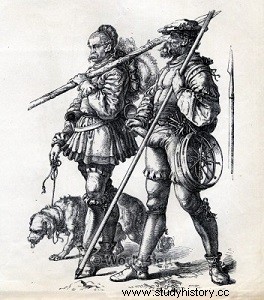
From the German Landsknecht, attested since 1480, Knecht (valet) indicating a servitude vis-à-vis the "employer" and Land (country or more certainly in this case campaign, plain) marking the origin of these mercenaries who did not come from the mountains, unlike the Swiss piqueurs. From 1500, we find the alteration Lanzknecht influenced by Lanze (spear, pike), the term Landsknecht is still found in modern German in the sense of mercenary (Söldner).
The lansquenets were mercenaries, often "German", if the word had any meaning at the time, and operating from the 15th century to the 17th century. The Swiss troops having demonstrated on several occasions that the best cavalry was powerless against infantry equipped with pikes reaching up to 6 meters in length, many sovereigns decided to create units on the model of these Swiss "Reislaüfer". In Bavaria, one of the main mercenary leaders in the service of the Emperor was Georg von Frundsberg. In Florence, for example, there is the Loggia dei Lanzi, so named because of the presence of German mercenaries stationed nearby. It was the beginning of the era of glory of the lansquenets, of which Maximilian I of Habsburg (1459-1519), nicknamed the "father of the lansquenets", perhaps marked the apogee.
As sought after as the Swiss, they put themselves at the service of all the sovereigns of Europe, in particular the King of France, and marked the history of their looting and abuses. A long pike was their main weapon but the halberd, shorter (about 2 meters) and various types of one- or two-handed swords also equipped their troops. The elite lansquenets, the Doppelsöldner (double pay), used for example the flamberge, a long sword that could easily kill a horse, but also the arquebus etc. A unit of Maximilian I's lansquenets ideally comprised 300 piqueurs and 100 Doppelsöldner, including 50 arquebusiers and 50 halberdiers, but over time this proportion evolved in favor of arquebusiers.
In their time of glory, the lansquenets marked not only the tactics, the armament and the harnessing (armour, coats, helmets, harnesses etc.) military but even the fashion of dress:starting from the observation that it was necessary to be at ease in his clothes on the battlefields, the lansquenets allowed themselves more and more freedoms, including in the "civilian", influencing European fashion. Nobles and clergy resented their extravagances which in some way encroached on their social status:the ecclesiastics in particular took a dim view of their finery suggesting bulky genitals, but Maximilian I had them granted by the Reichstag of Augsburg ( 1503) the right to dress as they please.
The lansquenets often behaved like soldiers and looters greedy for plunder and often closer to misery than glory because only the officers and the most famous of the lansquenets could afford the extravagances in question. Most were frowned upon by the population and for good reason:massacres, looting, thefts and rapes, fires, prostitution, nothing encouraging was to be expected from their passage. Even the social strata from which they came (day laborers, small craftsmen or companions, peasants or even convicts) and from which they hoped to extract themselves through pay, had a bad image of lansquenets.
The slightest injury was synonymous with infection, gangrene leading to death or amputation, venereal or other diseases were the daily lot, so life expectancy was particularly reduced. The fate of the survivors was hardly more enviable and cohorts of cripples or asocials living on theft and begging were part of the European landscape until at least the middle of the 17th century.
